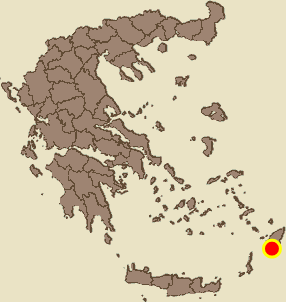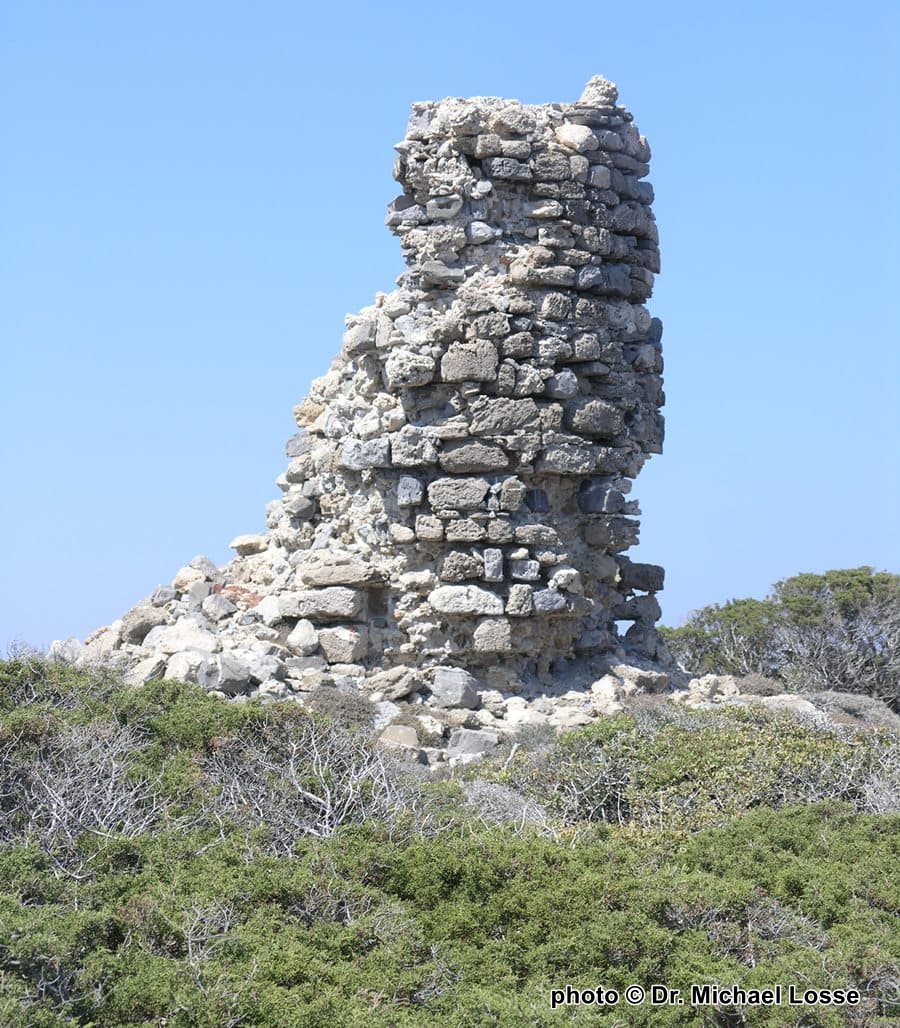Plimmýri, Rhodes, Dodecanese,South Aegean
Watchtower at Cape Jermata
| Location: |
| At Cape Víglas (Jermatá) on the southeastern coast of Rhodes Island, borders the bay of Plimmýri in south-western direction |
| Region > Prefecture: |  |
| South Aegean Dodecanese | |
| Municipality > Town: | |
| City of Rhodes • Plimmýri | |
| Altitude: | |
| Elevation ≈ 13 m |
| Time of Construction | Origin | |
| c. end of 15th cent. | IOANNITE |
|
| Castle Type | Condition | |
| Watchtower |
Rather Poor
|
Ruins of a cylindrical late-medieval watchtower (vigla) at Cape Víglas, Jermatá, on the southeastern coast of Rhodes Island, south of Plimmýri.
Tower Description
Text: Dr. Michael Losse – Singen (Hohentwiel), GermanyGeneral description
The narrow, elongated peninsula Cape Víglas – crowned by the ruins of a watchtower built by the Chivalric Order of the Knights of St John (Hospitaller Knights) – on the Rhodian SE coast borders the bay of Plimmýri in south-western direction. Peter Lock (2006) also mentioned the place-name “Cape Jeremias”, presumably it is a confusion with the local name “Akra [Cape] Jermatás”.
The tower is listed as a landmark for navigators (entry “short black tower”) in the British Admirality’s‚ The Mediterranean Pilot (Vol. 4, London 1941, p. 258).
The small, heavily destroyed round tower (Ø 3.8 m) stands just next to the NE edge, about in the middle of the peninsula, about 13 meters above sea-level. It is still about 5m high, which is almost the original height (Lock 2006), and seems to have consisted of a massive substructure with observation platform, the parapet of which is partly preserved (so-called “platform type”; cf. the tower of Cape Fournoi on the West coast of Rhodes).
According to this, the little tower would only have been able to climb from the outside with a ladder.
Various stones, mostly non-local, were used as building material, which were walled in clean layers with brick tweaks. Many stones and large parts of the brick material seem to have been used in secondary use.
Since the remains of ancient and Byzantine settlement have been preserved on the northern edge of the Plimmýri Bay (cf. Berg 1862, p. 159), it is obvious that Cape Víglas may have been the site of a tower or fortification in the past, to protect the bay used as a port. In the inland surrounding area of the tower there are traces of medieval settlement.
Under dense vegetation, foundations of mortar masonry in two-shell technology are recognizable in various places. As on Cape Fournoi, there may have been a barrier to seal off the peninsula. Residential buildings of the tower crew are also to be assumed on the peninsula, with which the cistern on the plateau could be related.
There were visual connections with different watchtower sites and fortifications on the island (amongst others: site of former Plimmýri watchtower; area of the presumed watchtower site of Mavros Kávos; Vouní, Mountain close to Mesanagros with Byzantine fortification).
Access (route / entrance)
The trail leads under residential buildings along the beach and then over a steep footpath to the peninsula.
Free access.
History of the castle/tower
The tower was built in the context of the construction of the watchtower system of the Order of the Knights of St. John (Hospitaller Knights) on the island of Rhdos towards the end of the 15th century, when the Knights started to built a „chain of watchtowers“ around the island. Details and exact dates are not known.
Other Info
SourcesGerola, Giuseppe: I monumenti medioevali delle 13 Sporadi. In: Annuario Scuola Arch. Atene I, 1914, pp. 319-356; II, 1916, pp. 29-54; here Part I, p. 354.
Lock, Peter: Freestanding towers in the countryside of Rhodes. In: Elizabeth Jeffreys (Ed.): Byzantine Style, Religion and Civilization. In honour of Sir Steven Runciman. Cambridge 2006, pp. 374-393, here p. 380, No. 6.
Losse, Michael: Wacht- und Wohntürme aus der Zeit des Johanniter-Ordens (1307-1522) auf der Ägäis-Insel Rhódos (Griechenland). In: Burgen und Schlösser 4, 2009, pp. 245-261.
Losse, Michael: Die Burgen und Festungen des Johanniter-Ritterordens auf Rhódos und in der Ägäis (Griechenland) 1307-1522. (Publisher: Nünnerich-Asmus Verlag) Mainz 2017.
Losse, Michael: Die (Küsten-)Wachttürme des Johanniter-Ritterordens auf der Insel Rhódos (Dodekanes, Griechenland) bis 1522 – Zum aktuellen Forschungsstand. In: fortifikation. Fachblatt des Studienkreises für Internationales Festungs-, Militär- und Schutzbauwesen e.V. (INTERFEST), Vol. 34, 2020, pp. 59-90.
Losse, Michael: Johanniter-Wachtturm am Kap Víglas, www.burgenwelt.org/griechenland/jermata/object.php (created: 2020.11.21).
Photos
(photo © Dr. Michael Losse, 2007)
| First entry in Kastrologos: | December 2020 |
Sources
- Text and photographs (2007) by Dr. Michael Losse
|
|
| Access |
|---|
| Approach to the monument: |
| The trail leads under residential buildings along the beach and then over a steep footpath to the peninsula. |
| Entrance: |
| Free access |




